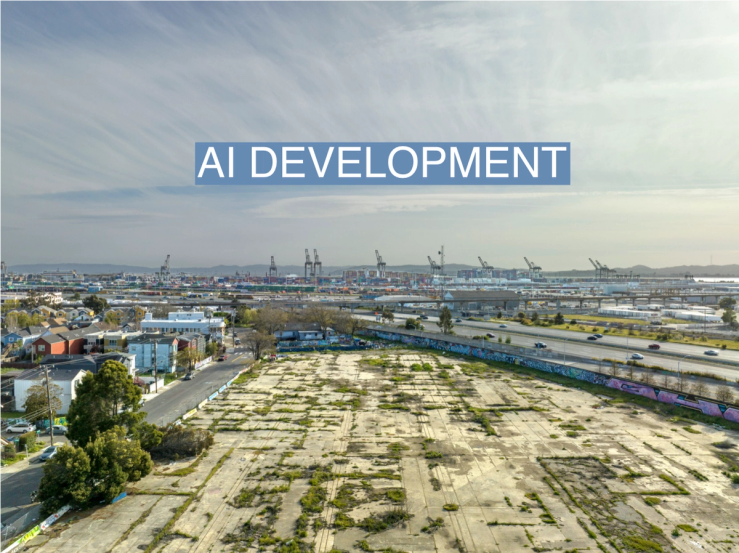The Scene
Holliday Development’s plan to turn vacant land in the San Francisco Bay area into low-income housing had been in limbo for years because of rising costs, like financing that became more expensive.
Over roughly the last year, that has all changed, with residents of “The Phoenix” expected to soon move into the 316-unit complex in West Oakland. One of the main factors in the turnaround: Artificial intelligence.
With all the focus on ChatGPT, some of the most profound impacts of AI on the real world are going unnoticed, such as developments in the construction industry. And that’s partly because AI’s role in projects like The Phoenix do not involve obvious manifestations, like robot workers or self-driving construction vehicles.
The developers of The Phoenix say it’s unlikely the project would have made financial sense were it not for the use of AI. Holliday says the project now costs about $400 per square foot, about 25% less than comparable buildings, and it will take about three years to complete.
That technology could be particularly helpful for California, where costs are often prohibitive but the state is about 3.5 million units short of the housing it needs by 2025 and has one of the highest homelessness rates in the country.
The key to the Phoenix AI design tool was time savings. California offers subsidies for housing developments that can be built within aggressively short time frames. By cutting down the design time, the project was able to take advantage of subsidies worth more than $25 million. Fifty units in the project will be reserved for people who were formerly homeless.
“It makes me hopeful that we’re thinking about new ways of not just designing and building, but also demonstrating means of doing it more efficiently,” said Jamie Hiteshew, director of development for Holliday Development.
In this article:
Know More
The Phoenix is a kind of proving ground for methods of design and construction that rely on modern technology in an industry that rarely benefits from innovation.
Located next to a highway, the building suffered from noise pollution, while the industrial Port of Oakland sits on the other side. To get community approval for the project, the developers needed to reduce the noise from the highway and, at the same time, ensure that all of the units had nice views.
Holliday Development worked with Autodesk, which used machine learning to model the effects of building shapes on the way sound from the highway traveled into the units. The models were also used to make subtle shifts in orientation to reduce noise as much as possible.
Then, the design of the units was changed slightly in order to optimize each unit’s view. To get there, the models were able to spit out numerous configurations of buildings until the best option presented itself while taking into account the complex effects of even slight changes, like in plumbing.
“It’s just beyond what an architect can do in their head,” said David Benjamin, who leads applied research at Autodesk.
Autodesk also used an AI model to learn from past projects that had been built with prefabricated modules, which were also used in The Phoenix. The AI learned from them and then used those patterns to create a new project within the footprint of The Phoenix. On Monday, Autodesk announced details of the project at Autodesk University, its annual design conference.
“AI will help people make material and design choices that they would have never thought of making prior to this new stage of industrialized construction,” said Andrew Anagnost, President and CEO of Autodesk.
And AI was also used to cut costs by optimizing for the least amount of construction waste. Normally, big housing projects end up with a lot of extra drywall and lumber. Suppliers only make those products in certain sizes and humans on their own don’t have the time to calculate how slight tweaks to a design could reduce the needed material. But computers do.
Reed’s view
When discussing the AI boom, we often talk about the potential for job losses due to automation. But here’s an example of a big construction project that wouldn’t have happened, along with the jobs that came with it, without AI.
While Autodesk and other companies have been working on this kind of AI — you might call most of it plain old machine learning — for some time, the advances in the space have rapidly increased in the last couple of years. With ChatGPT creating an AI boom, the advances will happen even faster now, and we’ll see more automation seeping into these projects.
Nobody can predict whether this kind of technology could alleviate California’s housing crisis — or the country’s — but it does offer a roadmap that other developers could follow to reduce costs and increase the speed of projects.
That could be especially important in an era of higher interest rates that have torpedoed so many construction projects already.
Room for Disagreement
As this New York Times article points out, the use of AI in construction is no panacea. “The industry’s embrace of A.I. technology faces challenges, including concerns over accuracy and hallucinations, in which a system provides an answer that is incorrect or nonsensical.
And further data collection has been a knotty problem, in large part because of the nature of huge construction projects: No two developments are the same, with wildly varying topography and local regulations, and new teams of contractors and subcontractors coming together for each project. It’s akin to starting a multimillion-dollar business for every sizable project.”
Notable
- Is the prefab construction market finally starting to take off after years of not-so-successful investments from venture capital? This Reuters article says shipments are up this year after a post-pandemic drop.


